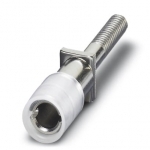Band heaters are another kind of heating devices whose operation is based on the emission of infrared waves that heat is not transit environment, as objects, they achieve - waves, "resting" in the surface of the object, forcing its molecules to vibrate, resulting in an object heated.
They are used relatively recently, so widely has not yet received, but due to the high specifications are promising direction in solving heating problems at home and at production.

Let us consider what constitutes Band heaters, their device characteristics and functionality.
What is heatertape (Engle)
The problem of process heating equipment, tanks, pipelines and facilities exist for a long time, especially in the northern latitudes. To solve this problem has been necessary to develop a flexible electric heating element (ENG) - security devices that can be placed on the surface of the heated equipment, repeating his profile. The first step in solving the problem was the creation of electrical heating cables with a conductor of predetermined resistance material, which, passing through the current itself, convert electrical energy into heat.

Cable heaters are still being used in the home and in industry, but more sophisticated device for heating is the next step is heating problem solutions - Engle, the heating element is a flexible belt that consists of several cables arranged in tape. In fact, Engle is an improved variant of the cable heater,
The apparatus and components belt heater
Engle represents wicker of glass fiber tape (base), in the middle along which the parallel are arranged a plurality of heating filaments of an alloy with high resistivity (nichrome - nickel chrome). Exterior tape coated with a waterproof sheath of silicone rubber, which is also of crimping the ends Engle performed. Connecting rod heater to the network is made via an electrically exiting the crimp terminal that connects with a tape heater yarns.
By type of consumed voltage heating tapes are produced at 12, 220 and 380 V.

The main element of the ribbon heater determining its characteristics, is a heating cable, which is composed of rows inside the tape. To have a better understanding of the characteristics Engle, consider the types of cables that are used for heating.
Cables heating
According to the principle of the heating cables are divided into:
- resistive - a fixed capacity and the heating wire in the role of a heat source placed in a 3-layer shell (electrical insulation, shielding braid and protection from ultraviolet radiation);
- self-regulating - two parallel conductors (phase and neutral) at a distance of 1 cm with interposition them heat source - matrix, which is heated while passing through it a current from the phase wire to zero.
single-conductor cable has only one heating wire, so you need to be connected to the network both ends (the turns of the cable needed positioned so that the distal end back to the starting point, and both contacts were cable nearby);
twin cable It consists of heating and current-carrying conductors, the currents that flow in different directions - the negative factors of the magnetic fields wires cancel each other (two-core cable is connected to the network at one end, a second end it has a special coupling);

 Types of tape heaters
Types of tape heaters
Depending on which device the heating wire is used in a tape, Engle, identical cables are divided into resistive and self-regulating.
Resistance Band heaters consist of several (2 to 8) one or two-core heating cables placed in the base, which is a wicker of glass fiber tape coated with a waterproofing coating. Included Angle with resistive type to avoid overheating of the thermostat must be, since the resistance of the structure and capacity of cables of heat in such devices - has constant magnitude.

To connect to a power source device has terminals disposed, depending on the design of the device, on one or both ends of the tape.
The length of the resistive Angle during installation can not be changed, that is, cutting the ribbon for packing to the size of the heated equipment is excluded.
Self-regulating strip heaters - is improved devices and cables of identical design having a flat section at the expense of larger area matrix.
matrix plate arranged in parallel between reaching copper wires are made of a material, the resistance which during the passage through it a current from the phase conductor to zero changes depending on the ambient temperature environment. Consequently, the degree of heating of the matrix and the amount of heat transfer is also dependent on this temperature, i.e., when the air temperature rises matrix cools and produces less heat. The parallel connection of the conductors in the cable allows you during installation of heaters to cut the tape into pieces of desired size without loss of functionality.
Characteristics
following their characteristics are used to organize and simplify the selection of the desired device of the plurality of types of tape heaters:
- symbol;
- connection type
- type heater;
- Resistance (Ohm);
- the active part of the length (m);
- width x thickness or diameter (mm);
- low temperature wire length (m);
- minimum bend radius (mm);
- weight (kg);
- Rated voltage (V);
- capacity of heat (W / m);
- power consumption (W);
- surface temperature (oFROM).
These characteristics are used in the calculations of heating systems, necessary for the process or working temperature piping, equipment and premises.
Areas of use
Scope band heaters is wide, but for space heating are still rarely used.
Division of spheres of use Angle into two parts:
- household;
- manufacturing
- and a closer look at the functionality of these devices.
Household Band heaters
In the conditions of frosty winters communications (water, sewage), private homes, cottages, rural housing is always in need of protection. For this purpose, lines and units disposed in cellars, basements or attics insulate thermal insulation materials and zaglublonnye in soil pipe below it were laid freezing. With the advent of tape heaters solution to this problem is significantly simplified - pipes, shut-off and the valve assemblies have become protected from thawing device by cable or belt electric heating.

In this method for arranging the tape or cable allows to vary with the degree of heating and material consumption. If the aim is to protect the water from freezing, the tape can be sent along the pipe linearly. If it is planned to receive the outlet water at room temperature, it is possible to insulate the pipe, placing Heatable serpentine strip, or to equip the system of running water over the linear arrangement of the heat insulating tape layer material.

More accurate results can be obtained using complete with a ribbon heater thermostat.
Sewer system private buildings also needs to be protected from frost, but excessive heating line is useless. Therefore, the sewer pipes equipped with tape heaters linearly arranged on a system, and is mounted on top of sewage heat insulation layer with a protective casing.

It is gaining popularity and the use of tape for mounting cable heaters icing systems on roofs private homes in order to prevent the dangerous formation of ice dams in gutters and icicles.
Important! It should be remembered that the use of resistive heaters for icing system installation is impractical, because they sensitive to an overlap of the cable or the belt, when one round is on the other, and clusters of leaves on them - the system in these areas quickly burn out.

Band heaters are also used in greenhousesSince not create enough for growing thermophilic cultures are required temperature and humidity - ground needs warming. Heating in this case arranged on the specially configured preparing a base - the heat insulation layer, on top of which runs horizontally and is aligned sand filling. Tape laid on top of a heating layer of sand was repeated, and then a base coated with a reinforcing steel mesh and a layer of fertile soil. In this case, the resistive ribbon stack is also inappropriate - requires self-regulating.

Band heaters found application in automotive engineering as well as operation vehicles in the winter time is significantly hampered due to thickening of engine oil and diesel.
Important! Implementation of heating assemblies and vehicle lines should be performed only tape heaters calculated on-board network 12, and according to the manufacturer's instructions for use, designed specifically for the type of engine (petrol or diesel) and certain of its node.

The operating instructions automotive belt heater is also said if allowed DIY installation of this device on the car, or whether it should be performed in a specialized the service station.
In view to meeting these requirements, the tape heater can be heated:
- salon;
- housing;
- for diesel engine:
- fuel filter;
- fuel;
- outside the fuel tank in place of the pump arrangement;
- Canister with diesel fuel;

- sumps dehumidification;
- battery.
The use of tape heaters in the industry not less widely spread, they are used for heating tanks with combustible fluids, process and main pipelines, pipeline, and pumping equipment, valves, etc. The list of technical equipment requiring technological or preheating during operation, it is very great.

Installation of industrial use devices made by specialized organizations on the basis of design data, calculated taking into account all available factors.
Advantages and disadvantages
Positive characteristics in band heaters are many, we list the main ones:
- efficiency;
- easy installation;
- wavelength in the range of harmless;
- the choice of devices with safe surface temperature.
However, there are drawbacks:
- Device sensitivity resistive to external influences (overlaps intersection);
- the need to use a resistive ribbons thermostats;
- the high price of improved self-regulating tapes.
Safety requirements
It is forbidden to:
- heaters use in hazardous areas and devices;
- operation of objects without heating the ground;
- Installation and use of devices with mechanical damage and low temperature sealing sheath wire;
- violating the integrity of switching terminals;
- maintain and repair the device without heating PPE (PPE).


